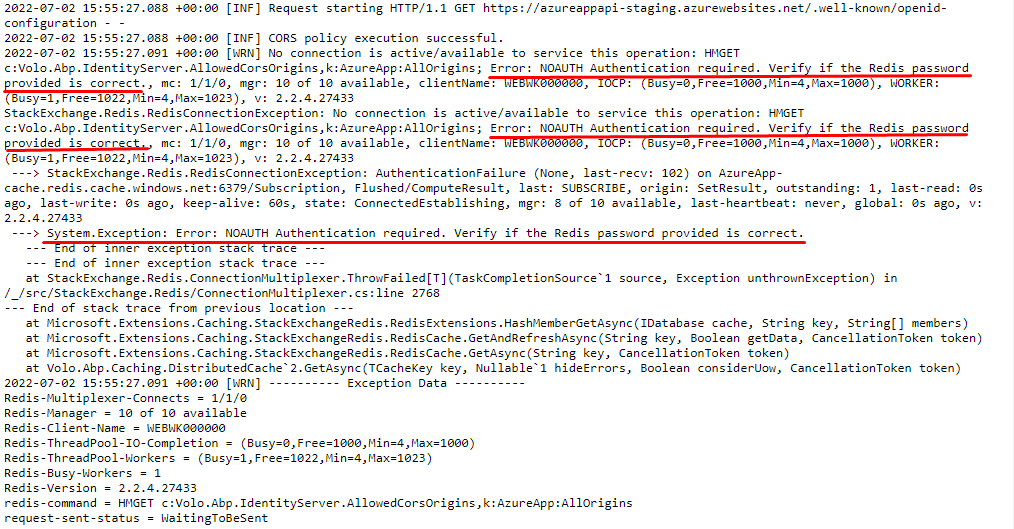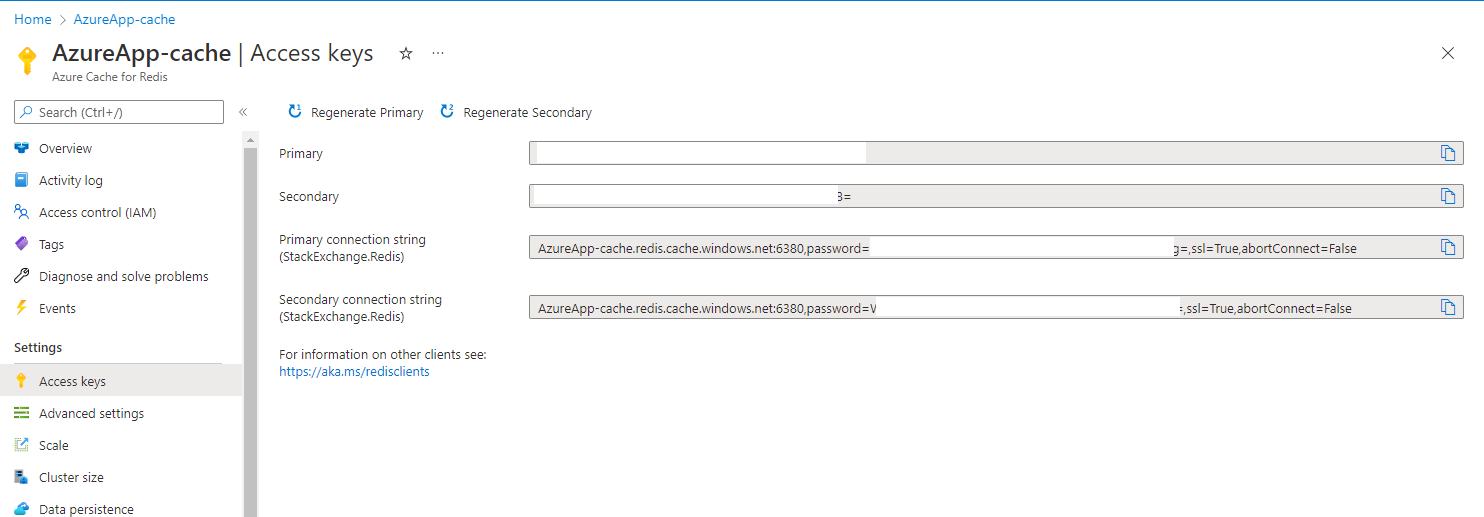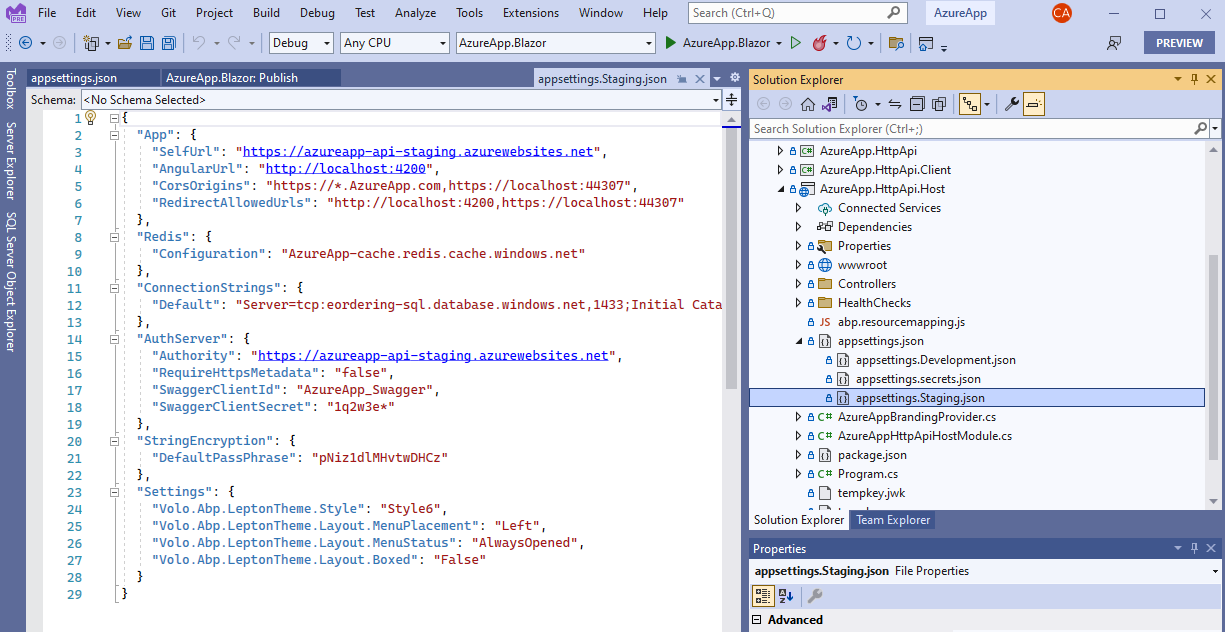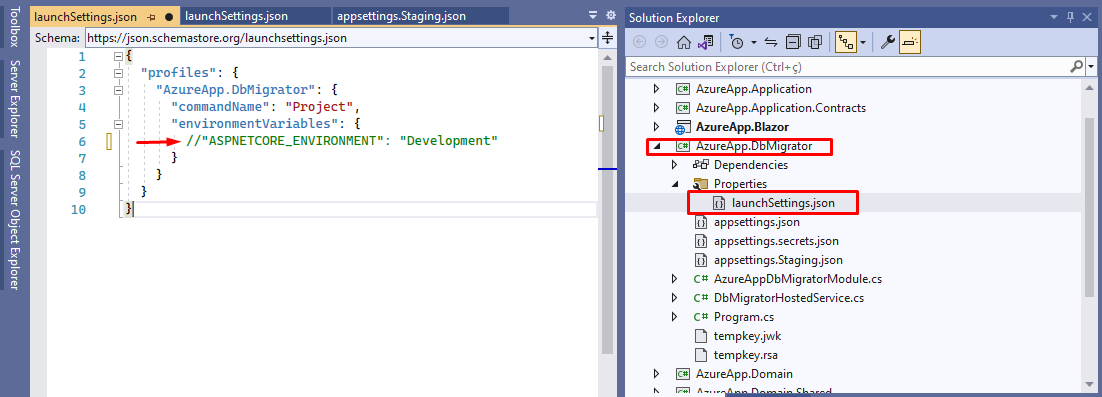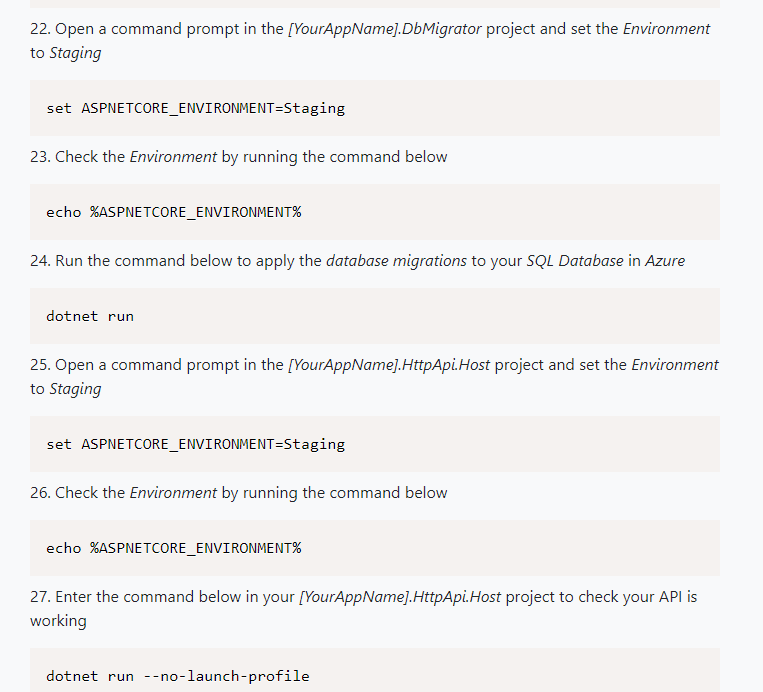Activities of "chrisalves"
hi
I tried to replace the Redis Cache "Configuration" in the appsettings.json with the AzureApp-Cache connection string but after this, the Swagger doesn´t load and gets error. I´ve tried to add only the password after the Redis Server separeted by Comma, but it also did not work.
Please share the related error logs.
Hi Maliming, Thanks for your return. Here is the new log, containing data from today (July 6th, 2022): https://sasdsupport.blob.core.windows.net/serverlogs/azureappapi-staging-logs-2022-07-06.txt
I´ve made some tentatives to solve. I updated the solution files to ABP Commercial 5.3.1 including all packages using the ABP Suite feature as you can see in the CLI outputs:
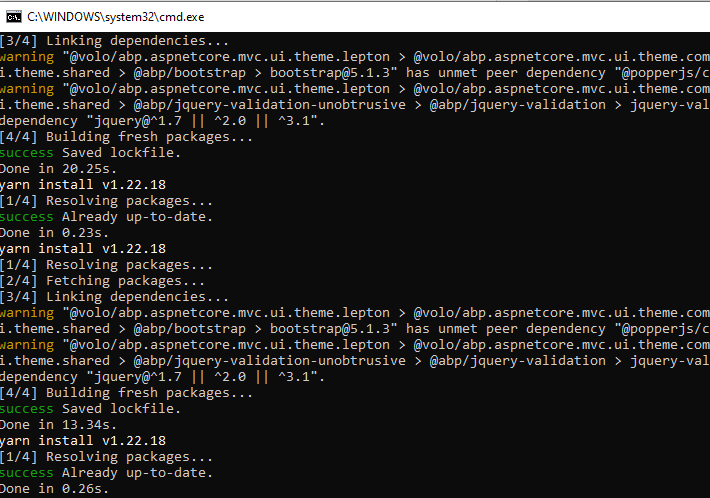
After this, I build the entire solution using Visual Studio 2022.
After this I updated the Redis Configuration in file appsettings.json as presented in the picture below.

I´m not sure what is the root cause, I believe it could be the version of ABP. Now the Application is working.
Hi Maliming, I reported an error about the ABP tool created with ABP Suite, using the ABP default process, and it is not working on the remote servers. Someone in the Support side requested to submit the Log to investigate what can be the error. You are sending an Article from Microsoft and I do not understand the why you are sending this article for me, because the Azure Cache is configured correctly. The problem is certainly related to the configuration of ABP application side, and there is not information on how to configure the application to run correctly with the Azure Redis Cache. Please send to this ticket the step by step process to make configure the Redis Cache, what shoud be done in the ABP Commercial/framework, to allow the applicatioin works correctly.
Thanks,
Christian
using Microsoft.AspNetCore.Extensions.DependencyInjection
Thanks. I added this "Using" and now it is building correctly.
Thanks
On screenshot 3 you get 500 error. Can you share the related error logs of azureappapi-staging. The logs can be found under the Logs folder with the name logs.txt
Hi! Thanks for you return. I took longer because I was trying to find a root cause, but I found in the log some traces of Redis Cache endpoint requesting the credentials. The log.txt file is available in the URL from my Azure blog storage (public access for read/download) https://sasdsupport.blob.core.windows.net/serverlogs/azureappapi-staging-logs.txt Below I present a cut of the log file where I found Error message and the Systems Exception related. I believe it is required to pass the credentials, but I did not find how to do this. Additionally, I found in Azure Redis Cache Service a connection string to be used by the application, so if it is possible to pass the connection string, it also can be a trial for the solution.
Additionally, I found these options on Azure Redis Cache available for usage, but I do not know how to apply it on ABP.IO I hided the Primary and Seondary secrets, but I belive we need to use the connection string in ABP.IO.
I tried to replace the Redis Cache "Configuration" in the appsettings.json with the AzureApp-Cache connection string but after this, the Swagger doesn´t load and gets error. I´ve tried to add only the password after the Redis Server separeted by Comma, but it also did not work.
Please, give a help! 😊
Hi Folks, I´m returning with the setup of Azure Webapp service and I´m facing problem on Blazor endpoint. Here is a summary explanation about the environment: -> 1 Azure Webapp Service for the API (project {AppName}.HttpApi.Host) -> 1 Azure Webapp Service for the Blazor Wasm (project {AppName}.Blazor)
in both Azure Webapp Service instances, the ASPNETCORE_ENVIRONMENT configuration is defined to Staging.
In both projects the files aspsettings.Staging.json exist and have the recommended URL set for the public endpoints.
I believe that the ABP default template for Blazor UI need extra configuration to work correctly on Azure Webapp Service because in my local PC the application runs sucessfully but on the Web, the Blazor endpoint is still waiting for anything instead of load the home webpage.
I created this appliction to debug the Deployment on Azure Webapp Services, so the application doesn´t have any sensitive information and then I will present here the real scenario without restrictions.
Here below is the API running on a real URL: https://azureapp-api-staging.azurewebsites.net/swagger/index.html (project {AppName}.HttpApi.Host existing in the Solution created by ABP Suite)
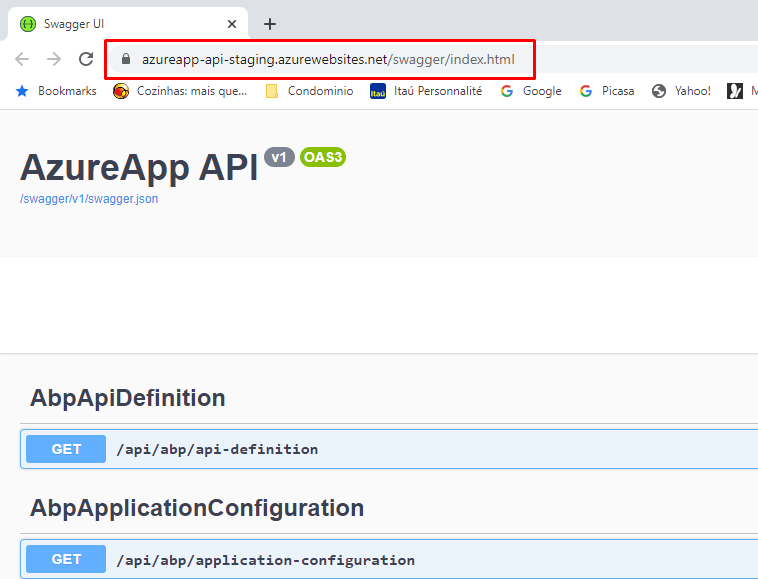 Here below is the aspsetting file content related to the API project {AppName}.HttpApi.Host poiting to Azure Webapp services
Here below is the aspsetting file content related to the API project {AppName}.HttpApi.Host poiting to Azure Webapp services
<br> The Blazor App is presented below. Here below is the WebApp running on a real URL: https://azureapp-web-staging.azurewebsites.net/ (project {AppName}.Blazor existing in the Solution created by ABP Suite)
Here below is the loaded information about the aspsettings file that was loaded in the Browser (the Blazor app). It was collected using the "Developer Tools" existing in Google Chrome browser. The same information appears when using MS Edge Browser.
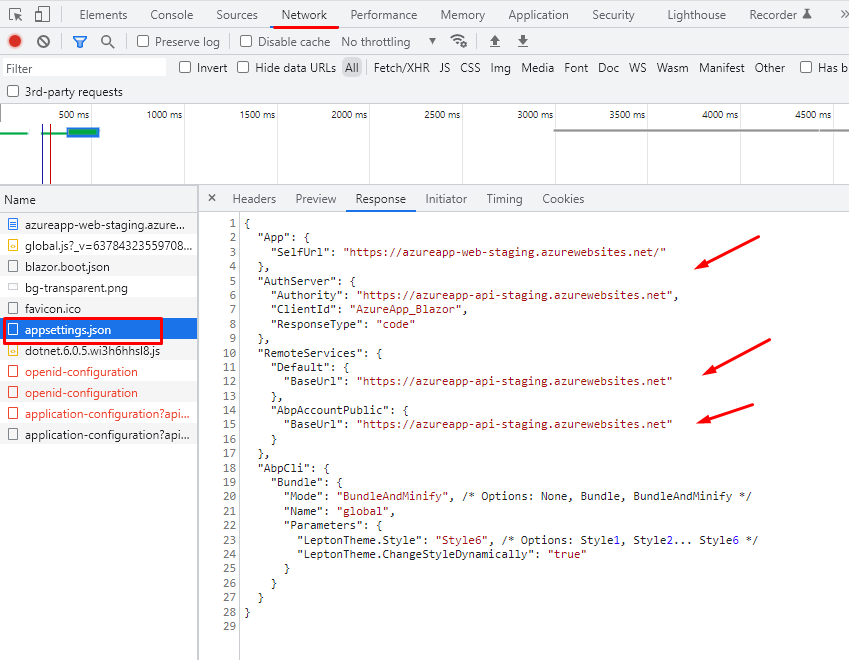
By this screen shot, it seems to be poiting to the correct API endpoint but the application does not load, the application keeps waiting for any answers indefinitely.
Please give help me to understand what need to be changed or fixed to have the ABP application deployed using Azure Webapp Services, because in the local PC the application is running fine.
Hi Folks,
I know that the file aspsetting.json can be customized for each environment and the connection string for each environment is already set as the picture below shows:
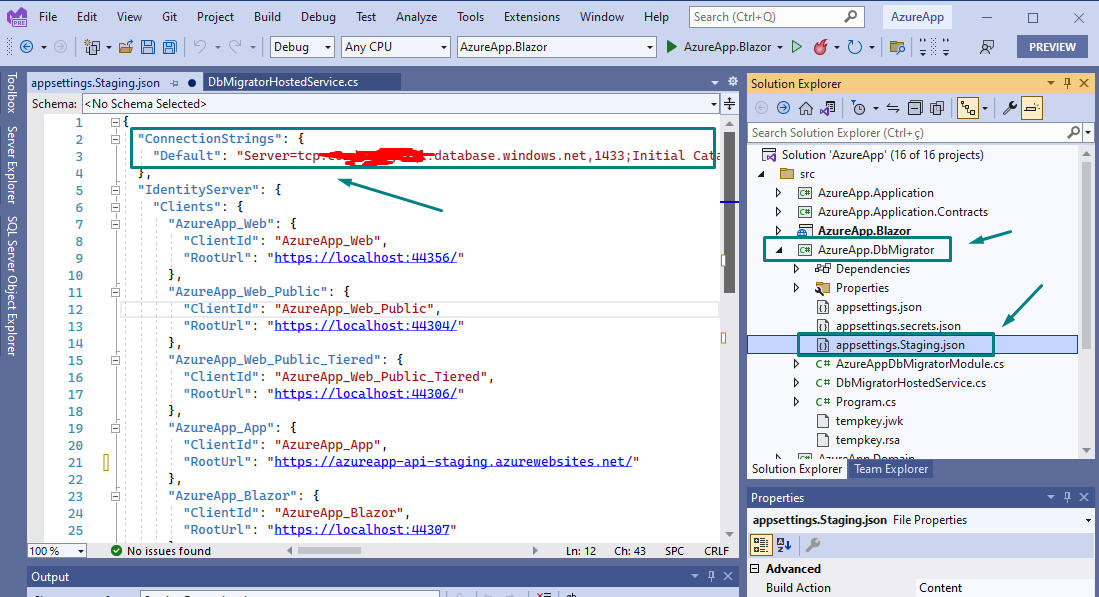
Similar aspsettings.json file can be prepared to development, production or any other environment. This is not the problem.
The question is: how to make make the WebApi implemented by "{appname}.HttpApi.Host" to understand that there is a migration pending and apply the migration to the Database once the new release is launched in the remote server? Is it possible to refer explain how to implement it? Or is there another strategy recommended by ABP.IO to deploy the application to multiples environments?
Hi Folks, Thanks for the reminder about the app type. Additional to the parameter, I needed to comment out the environment variable existing in the file "launchSettings.json" under DbMigrator "properties" because every time I did run the DbMigrator project, the "launchSettings.json" environment variable overrides the Operating System variable. So, it is good to comment out the environment variable if anyone is running in their local PCs.
Many thanks for all your help! I really appreciate it! 😊😊😊
Hi Folks,
I'm returning here with the same topic, after some tests made without expected results, the application is not being redirected as expected driven by the aspsettings.{ENVIRONMENT}.json
Considering the environment in Azure is more dificult to diagnose, I spend much time trying to solve, even rising a ticket with MS Technical support. After some researches on the web, I found an article in ABP.IO community that seems to be useful but probably was written for an old version of ABP Framework. The main idea is to present a way to integrate ABP.IO projects into Azure Webapp. Here is the article https://github.com/bartvanhoey/AbpIoAzureDevopsRepo
I found in the article a suggestion to run the application locally in the PC but pointing the Database to the SQL server hosted in Azure (remote database). Following the suggestion to set locally the json file and set the envonment correctly (please see the picture below) as cutted off from the article in the part 3 (https://abpioazuredevopsblazor.azurewebsites.net/part3)
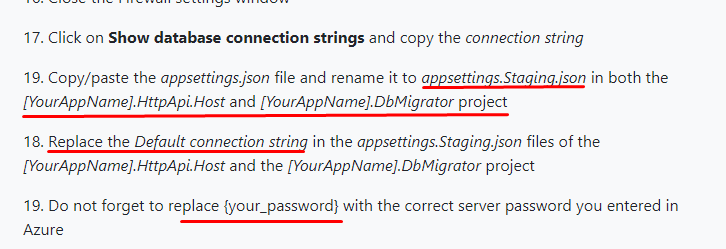
I skipped the section 20 of the article because if applying the recommened changes the code runs and get error. I believe it is because the recently ABP.IO release is not accepting the old code related to "BuildConfiguration()" because the actual release (5.2.1) has the template for Blazor WASM with a different implementation as shown below:
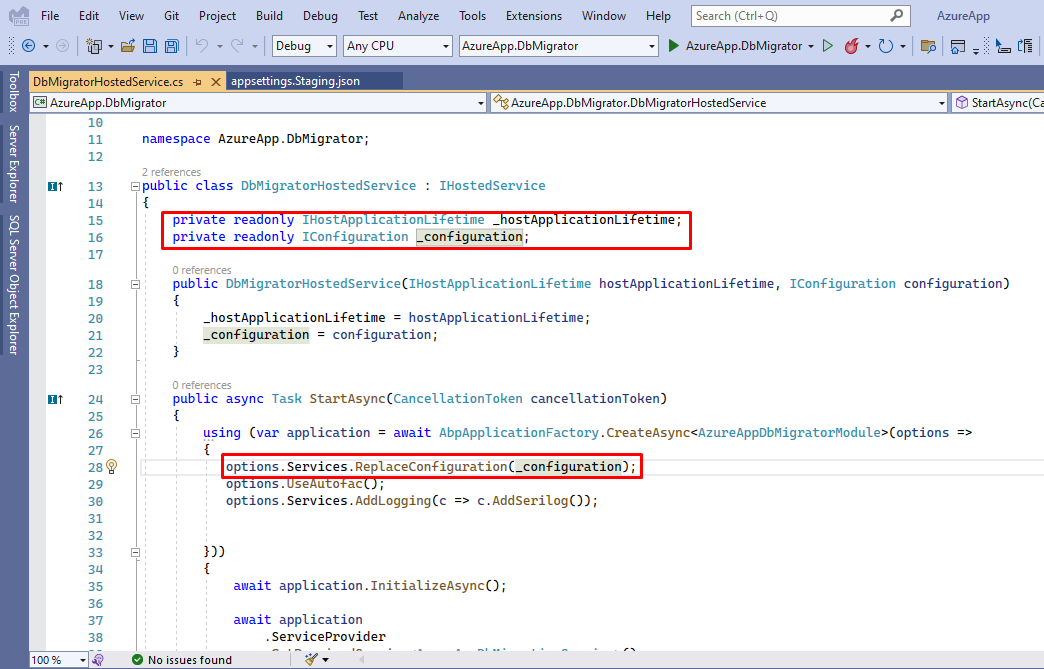 (Default implementation when using Blazor WASM template)
(Default implementation when using Blazor WASM template)
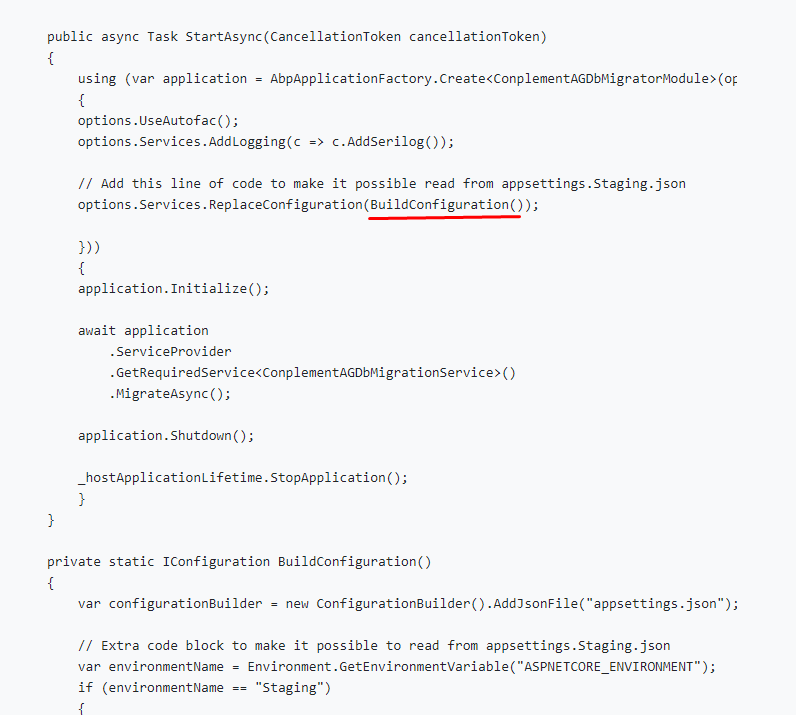 (Changes recommended by the article in the section 20)
(Changes recommended by the article in the section 20)
To test the environment settings, I followed the recomendations below
The picture below reproduces that I´m trying to setup the Staging environment.
The Seed process is always creating ans seeding data in my PC local database, not into the remote hosted by Azure. To ensure this symptom, I deleted the local database many times and ran again, always observing the local database being created again and again.
When I run the {ApplicationName}.HttpApi.Host with Enviroment set as "Development" then it runs perfectly, but when I set the Environment to "Staging" the API runs with error, and loops indefinitely getting errors. My guess is that the Json file is being considered by the {ApplicationName}.HttpApi.Host but it does not find the initial Seed of the database.
Please can anyone help with complementary procedures to allow the first step related to the database connection for a different environment than the default Development?
Many thanks!
Christian
<br>
Hi! I really appreciate your help! I found the file in the wwwroot folder of the Blazor Project as seen below and now I will work to provide multiples environments according to the MS article suggested.
I do appreciate your help!
According to the article you suggested, I will create the variables in Azure Static App that hosts the Blazor Application.
Many thanks!
Using Google Chrome, it always replace http for https. If I open in Microsoft Edge, it runs OK. But in Chrome, the URL always is being replaced by https .
